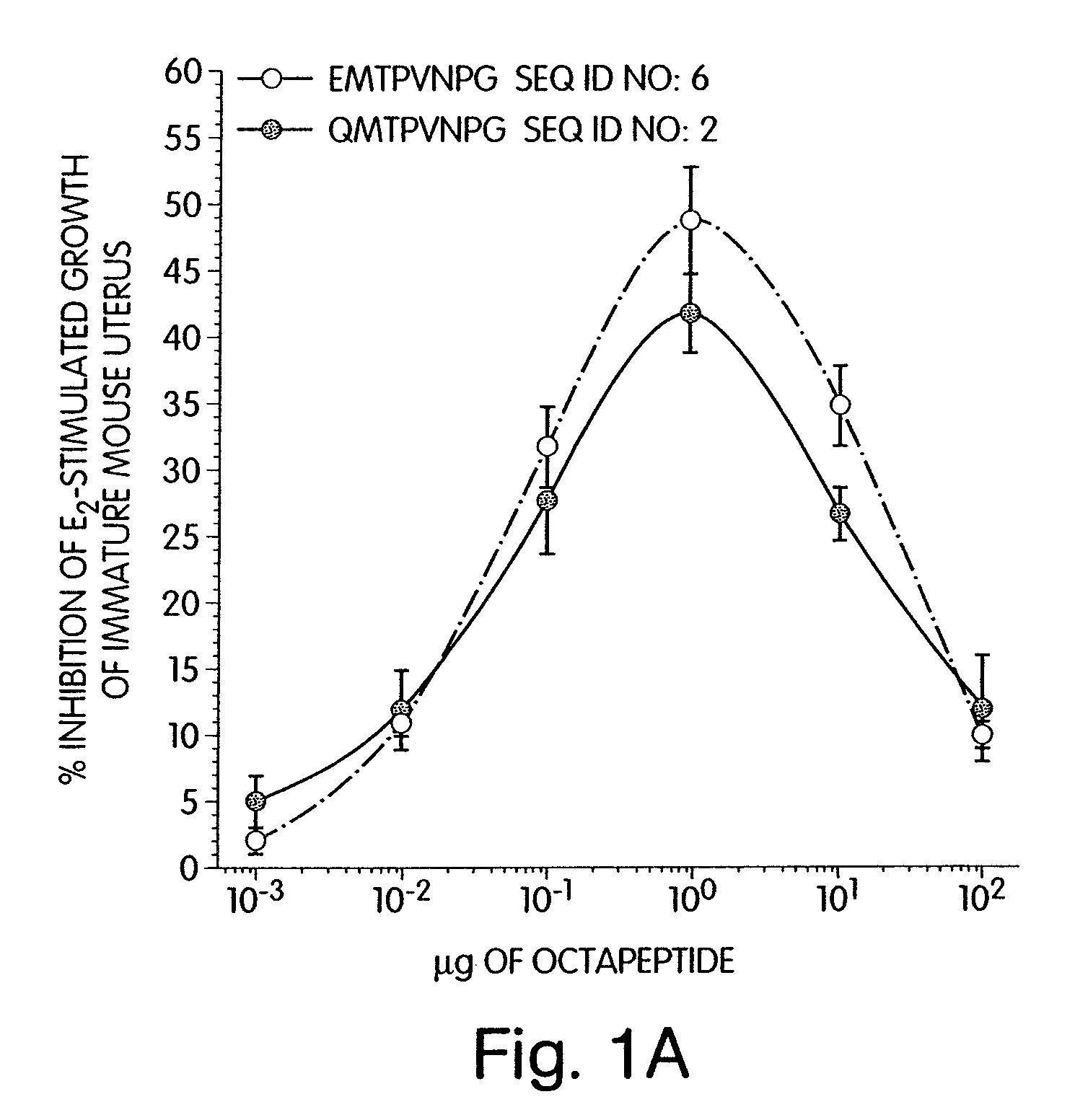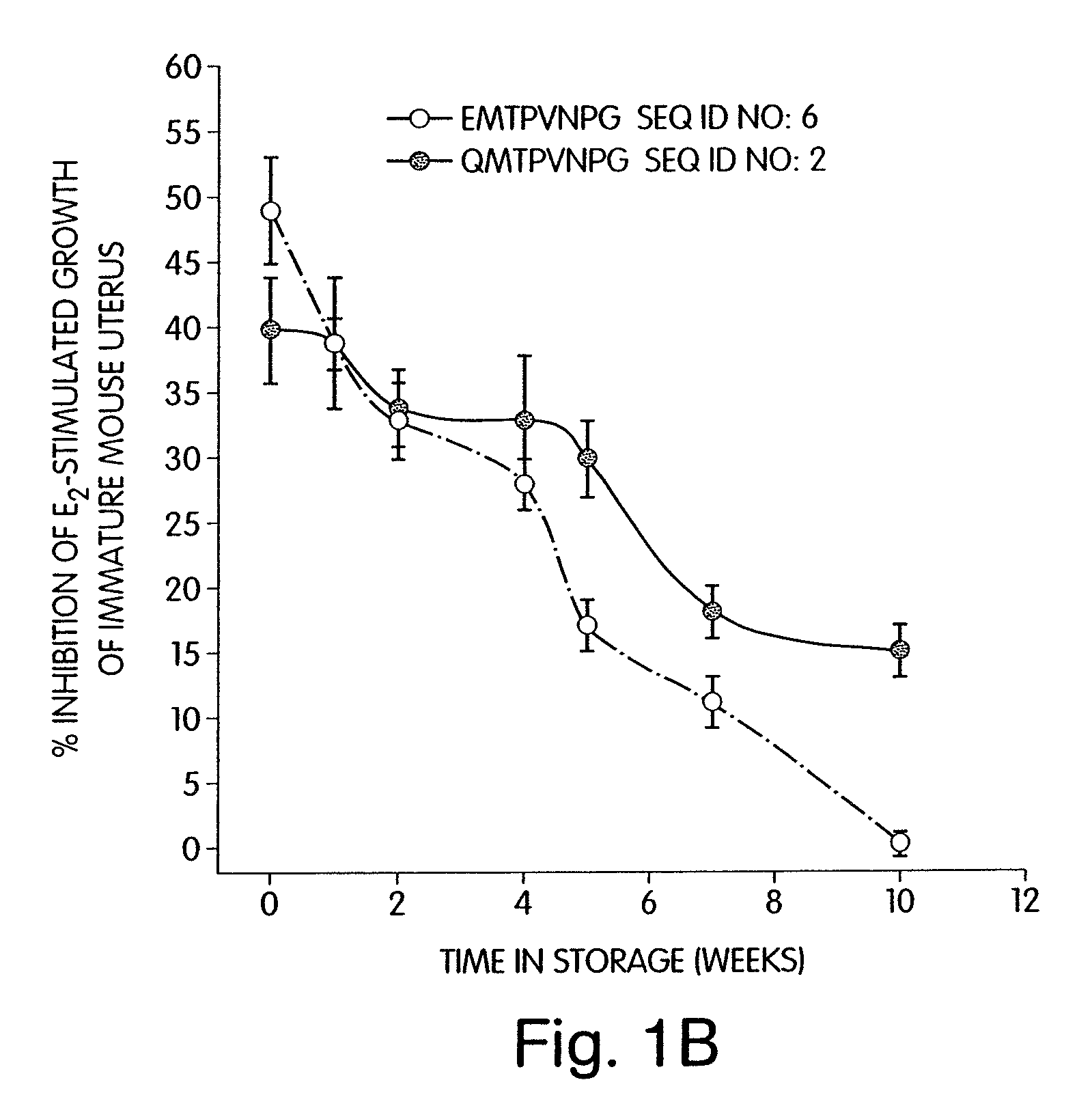Alpha-fetoprotein peptides and uses thereof
a technology of fetoprotein and peptide, which is applied in the field of peptides, can solve the problems of not all er+ breast cancers are sensitive to tamoxifen, and the+ breast cancers that are refractory, so as to reduce phosphoer, reduce pcna accumulation, and increase the nuclear accumulation of activated er
- Summary
- Abstract
- Description
- Claims
- Application Information
AI Technical Summary
Benefits of technology
Problems solved by technology
Method used
Image
Examples
example i
Development of a Synthetic Cyclized Peptide Derived from Alpha-Fetoprotein
[0194]Earlier, it had been shown that an energy-minimized structure of octapeptide SEQ ID NO:6, EMTPVNPG indicated that the peptide had potential to form a horseshoe shaped structure (Mesfin et al. 2000). Energy-minimization studies of an analog of this peptide, that would be generated by substitution of the N-terminal glutamic acid with glutamine (SEQ ID NO:2, QMTPVNPG), indicated that this product would have potential to bow even further inward and form a pseudo-cyclic structure. This pseudo-cyclic structure may have greater structural stability due to hydrogen bonding between the N-terminal glutamine γ-carboxamide group and the C-terminal glycine α-carboxamide. This linear analog (SEQ ID NO:2, QMTPVNPG) was therefore synthesized, and its biological activity was compared to SEQ ID NO:6, EMTPVNPG, in the estrogen-dependent immature mouse uterine growth assay. SEQ ID NO:2, QMTPVNPG inhibited the estrogen-stimu...
example ii
Prevention of Growth of Estrogen-Dependent Human Breast Cancers Sensitive and Resistant to Tamoxifen
[0199]An 8-mer peptide (SEQ ID NO: 4, EMTOVNOG) derived from alpha-fetoprotein (AFP) was compared to tamoxifen for activity against growth of human breast cancer xenografts implanted in immune-deficient mice. Both peptide and tamoxifen prevented growth of estrogen receptor-positive MCF-7 and T47D human breast cancer xenografts. A subline of MCF-7, made resistant to tamoxifen by a six-month exposure to this drug in culture, was found to be resistant to tamoxifen in vivo. Peptide completely prevented the xenograft growth of this tamoxifen-resistant subline of MCF-7. Neither peptide nor tamoxifen were effective in slowing the xenograft growth of the estrogen-receptor-negative MDA-M2-231 human breast cancer. A worrisome toxicity of tamoxifen is its hypertrophic effect on the uterus. In this study, tamoxifen was shown to stimulate the growth of the immature mouse uterus in vivo, and the pe...
example iii
Summary of In Vitro Effectiveness of AFP-Peptide on Cancer Cell Lines
Materials and Methods
[0205]Cell lines. Glioma cells: C6 cells were cultured in F-12K medium with 18% FBS. F98 cells and GL261 cells were cultured in DMEM with 10% FBS. Head and neck cancer: 22B cells were cultured in DMEM with 10% FBS. Papillary thyroid cancers: BHP2-7 cells and BHP18-21 cells were cultured in DMEM with 10% FBS. Small cell lung cancer: HTB184 cells were cultured in RPMI medium with 10% FBS. Breast cancers: MCF-7 cells were cultured in DMEM (w / o phenol red) with 5% FBS and MDA-MB cells were cultured in DMEM with 10% FBS. Colon cancer: Colo 205 cells were cultured in RPMI medium with 10% FBS. Ovarian cancer: OVCAR-3 cells were culture in RPMI medium with 20% FBS supplemented with insulin. Prostate cancers: LNCaP cells were cultured in RPMI medium with 10% FBS. DU145 cells were cultured in MEM with 10% FBS and PC3 cells were cultured in F-12 medium with 10% FBS. Cervical cancer: HeLa cells were cultur...
PUM
| Property | Measurement | Unit |
|---|---|---|
| pH | aaaaa | aaaaa |
| pH | aaaaa | aaaaa |
| pH | aaaaa | aaaaa |
Abstract
Description
Claims
Application Information
 Login to View More
Login to View More - R&D
- Intellectual Property
- Life Sciences
- Materials
- Tech Scout
- Unparalleled Data Quality
- Higher Quality Content
- 60% Fewer Hallucinations
Browse by: Latest US Patents, China's latest patents, Technical Efficacy Thesaurus, Application Domain, Technology Topic, Popular Technical Reports.
© 2025 PatSnap. All rights reserved.Legal|Privacy policy|Modern Slavery Act Transparency Statement|Sitemap|About US| Contact US: help@patsnap.com



